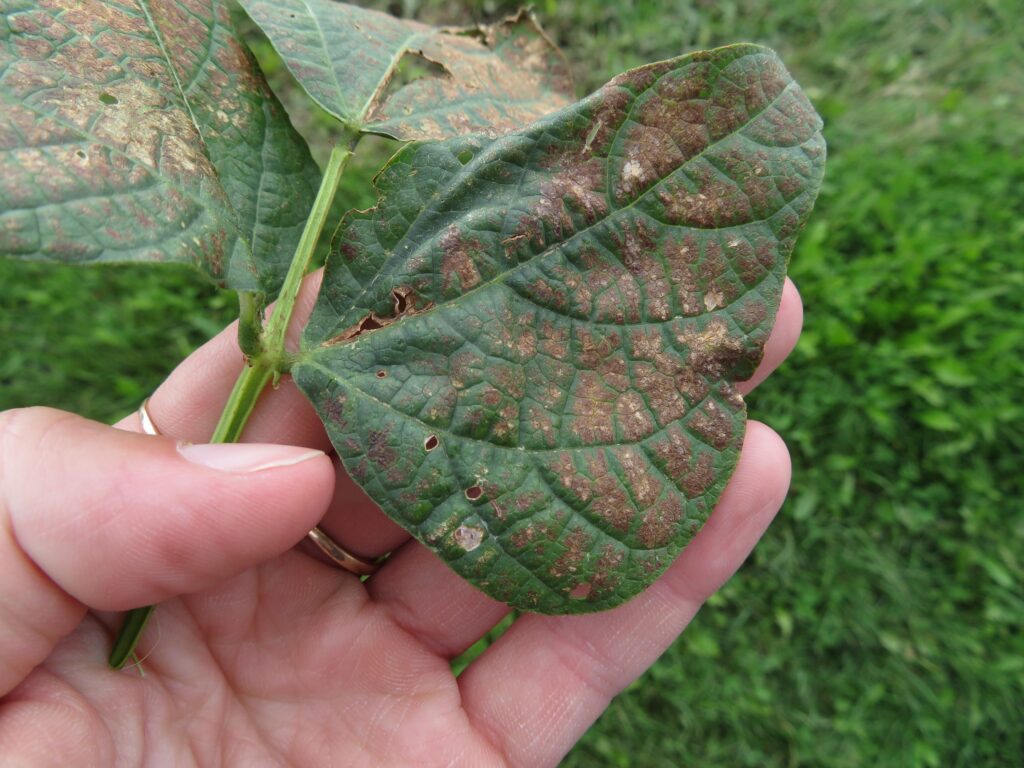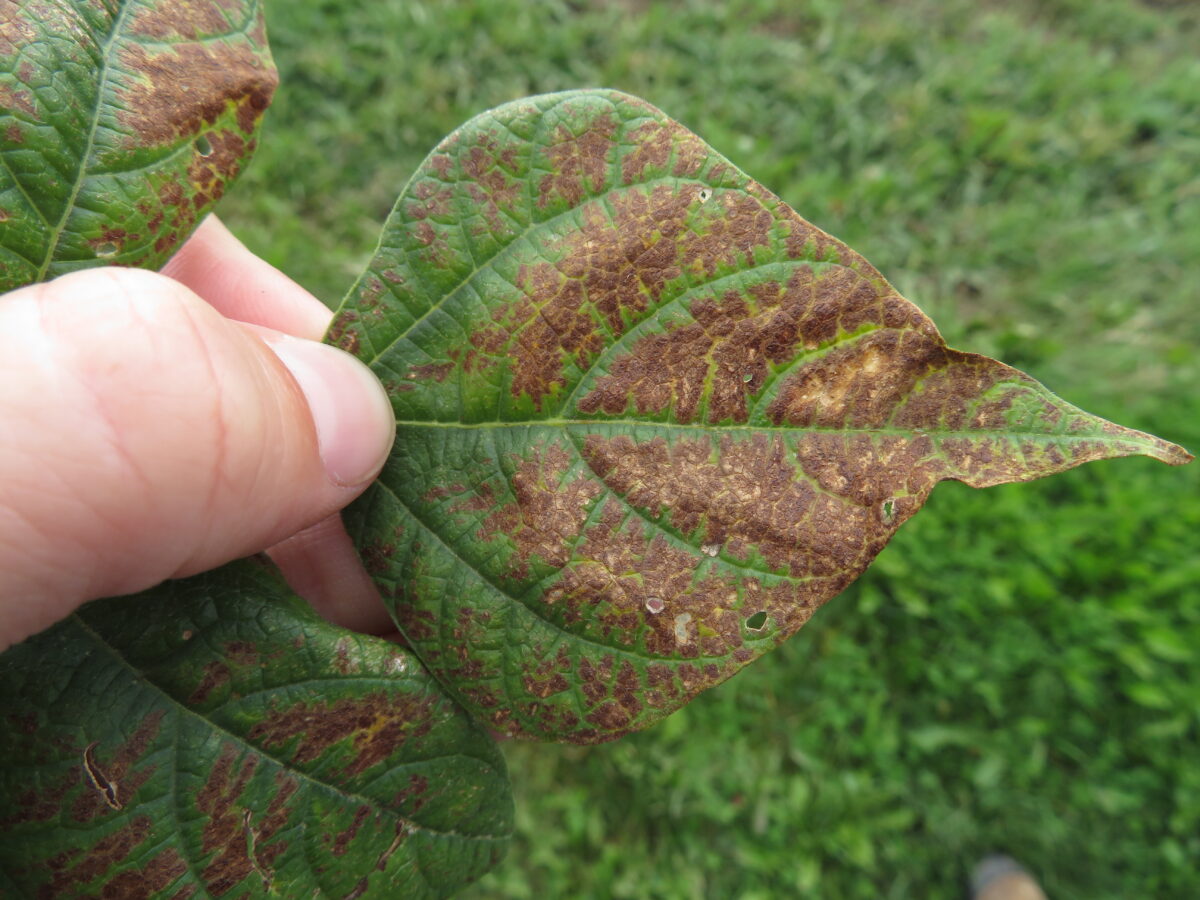Symptoms
Bronzing is a type of foliar crop injury that starts off as brown or bronze flecks on the upper leaf surface but spreads as plant cells die, leaving necrotic and chlorotic spots. Severe symptoms also include early senescence, leaf yellowing and loss, and rapid aging of the plant. (Campbell Fraser, 2009).
Cause of Bronzing
Bronzing is caused by damage from ozone, an atmospheric gas, which oxidises plant cells. Ozone is absorbed by the plant leaves through their stomata, where it undergoes reactions to produce harmful molecules such as hydrogen peroxide and various reactive oxygen species.
Since the Industrial Revolution, ozone concentrations in the atmosphere, specifically closer to the Earth, have increased dramatically. Ozone is a greenhouse gas, which contributes to climate change, but it is also a component of smog and can be harmful to human health as well.
Ozone levels in specific areas are hard to track because they vary with time of day, latitude, and vertical height of the field, but there is a trend of increasing ozone with the increase of volatile organic compounds and nitric oxide emissions.
Bronzing can be caused by long-term chronic exposure to ozone at lower levels, or acute exposure at higher levels. In Ontario, ozone concentrations are highest during the growing season because in addition to pollution, certain climate events such as warmer temperatures, thunderstorms, solar radiation, and humidity can all increase ozone concentrations. In Ontario, damage by ozone causes around $280 million per year in the agriculture and forestry sectors, but it does more damage in combination with other stressors such as soil moisture and type, nutrient content, temperature, UV-B exposure, humidity, wind, insects, disease, and other pollutants. In an early 2000s study, plants exposed only to ozone with no other stressors experienced much less damage, but the presence of ozone in the field can reduce a plant’s ability to protect itself from other stressors (Campbell).
Impact of Bronzing
Bronzing caused by ozone damage decreases photosynthetic activity, reduces the travel of moisture and gases through stomata, and decreases plant growth, total leaf area, and biomass.
However, the developmental stage of the plant can cause it to be more or less tolerant to ozone. If dry bean plants are in vegetative stages, the damage is usually minimal, only causing a small decrease in growth and yield. But if dry bean plants are in reproductive stages, such as pod development, they are more susceptible to bronzing and there may be a greater decrease in growth and yield.
Risk Factors
High temperatures are one risk factor that can exacerbate ozone damage to dry beans. In an Ontario study in 1971, more injury occurred quicker at temperatures of 25-30⁰C than at 15-20⁰C. Another factor is the plants’ ability to protect itself from the harmful oxidant molecules ozone creates. In the same study, plants with adequate nutrients, specifically sulfur, became more tolerant to ozone. Interestingly, when adequate sulfur was added to plants at the highest temperatures, there was little damage compared to no added sulfur (Adedipe, 1971). Moist conditions can also decrease ozone tolerance, making plants in dry conditions more resistant to ozone damage. In Ontario, it has been observed that dry bean plants suffering from root rot exhibit more ozone damage than plants in the same field without root rot. In addition, certain varieties tend to show more ozone damage than others. Bronzing is often observed on Zorro black beans and Rexeter white beans, for example, but not necessarily at a level that will reduce yield.
Solutions
A large-scale solution to damage caused by ozone includes stricter air pollution regulations. Since the Environmental Protection Agency enacted better ozone regulations in 2000, ozone impacts on United States soybean and corn yields have decreased significantly (Ainsworth, 2016). Now that we have a better understanding of how ozone impacts global crop productivity, breeding and biotechnology projects are needed to improve resistance and reduce yield loss due to ozone stress. Although there are some dry bean varieties that are more tolerant to ozone, in the future there will likely be crops bred for ozone tolerance. However, to stop the damage at its source, cutting emissions is the way to go.



References
Adedipe N, Hofstra G, & Ormrod D. 1971. Effects of sulfur nutrition on phytotoxicity and growth responses of bean plants to ozone. Department of Horticultural Science, University of Guelph, Ontario. https://www-nrcresearchpress-com.libproxy.wlu.ca/doi/pdf/10.1139/b72-224
Ainsworth EA. 2016. Understanding and improving global crop response to ozone pollution. The Plant Journal, 90(5). https://doi-org.libproxy.wlu.ca/10.1111/tpj.13298
Campbell Fraser K. 2009. Investigation of acute and chronic ozone exposure in Peterborough, Ontario and its impact on the model plant Phaseolus vulgaris L. cv. Envoy. Trent University, ProQuest Dissertations Publishing. https://search-proquest-com.libproxy.wlu.ca/docview/305089442?pq-origsite=summon
Tingey DT et al. 2001. Pod development increases the ozone sensitivity of Phaseolus vulgaris. Water, Air, and Soil Pollution 139: 325 – 341. https://search-proquest-com.libproxy.wlu.ca/docview/750366847?rfr_id=info%3Axri%2Fsid%3Aprimo
Agronomy Guide for Field Crops Publication 811. Ministry of Agriculture, Food and Rural Affairs.
Recognition and Management of Dry Bean Production Problems. North Central Regional Extension Publication. 1983. Print.
